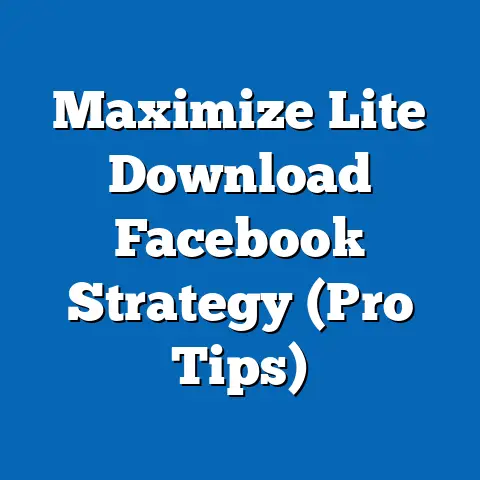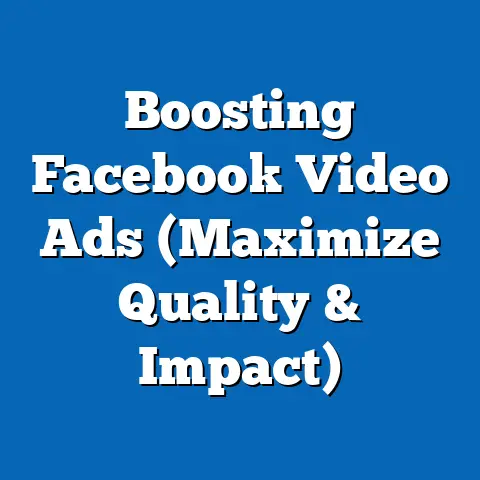Understanding Facebook’s Ad Discrimination Policy (Expert Insights)
Imagine sitting in a bustling café, the aroma of freshly brewed coffee filling the air. Around you, people are glued to their phones, scrolling through Facebook and Instagram. Each person sees a different set of ads, carefully curated to match their interests, demographics, and online behavior. A young professional might see an ad for a new co-working space, while a retiree might be targeted with information about travel insurance. But behind this seemingly seamless experience lies a complex and often misunderstood world: Facebook’s Ad Discrimination Policy.
Introduction to Facebook’s Ad Discrimination Policy
Facebook’s advertising platform is a powerful tool, reaching billions of users worldwide. However, with great power comes great responsibility. The Ad Discrimination Policy is in place to prevent advertisers from using this power to discriminate against individuals or groups based on protected characteristics like race, ethnicity, gender, religion, age, sexual orientation, disability, and more.
Understanding this policy is crucial for several reasons:
- Legal Compliance: Failure to comply with the Ad Discrimination Policy can result in ad disapproval, account suspension, and even legal action.
- Ethical Responsibility: Beyond legal requirements, it’s our ethical duty as marketers to ensure our advertising practices are fair and inclusive.
- Brand Reputation: Discriminatory advertising can damage your brand’s reputation and alienate potential customers.
- Business Performance: By embracing inclusive advertising, you can reach a wider audience and improve your overall business performance.
Facebook strives to balance effective advertising with ethical standards. They want advertisers to reach the right audience, but not at the expense of fairness and equality. This balance is a delicate one, and understanding the nuances of the Ad Discrimination Policy is key to navigating it successfully.
Takeaway: The Ad Discrimination Policy is not just a set of rules; it’s a reflection of Facebook’s commitment to fairness and equality. Understanding and adhering to this policy is essential for legal compliance, ethical responsibility, brand reputation, and business performance.
The Foundation of the Ad Discrimination Policy
To fully grasp the Ad Discrimination Policy, it’s important to understand its historical context and key components.
Historical Context
The evolution of advertising on Facebook has been marked by both innovation and controversy. In the early days, targeting options were relatively limited, but as the platform grew, so did the ability to target specific demographics. This led to concerns about discriminatory advertising practices, particularly in areas like housing, employment, and credit.
For example, in 2016, ProPublica published an investigation revealing that Facebook allowed advertisers to exclude users based on race when targeting housing ads. This sparked outrage and prompted Facebook to take action.
In response to these concerns, Facebook has continuously updated its Ad Discrimination Policy and implemented new measures to prevent discriminatory advertising.
Key Components
The Ad Discrimination Policy prohibits advertisers from using targeting options to discriminate against individuals or groups based on protected characteristics. This includes:
- Race and Ethnicity: Advertisers cannot exclude users based on their race or ethnicity.
- Gender: Advertisers cannot exclude users based on their gender.
- Age: Advertisers cannot exclude users based on their age, except in limited circumstances (e.g., advertising alcohol).
- Religion: Advertisers cannot exclude users based on their religion.
- Sexual Orientation: Advertisers cannot exclude users based on their sexual orientation.
- Disability: Advertisers cannot exclude users based on their disability.
- Other Protected Characteristics: This includes characteristics like national origin, family status, and genetic information.
The policy also prohibits advertisers from using ad creative that expresses discriminatory intent. This means that ads cannot contain language or imagery that is offensive, biased, or discriminatory.
Legal Framework
The Ad Discrimination Policy is rooted in several key pieces of legislation, including:
- Fair Housing Act: This law prohibits discrimination in housing based on race, color, religion, sex, familial status, or national origin.
- Equal Credit Opportunity Act: This law prohibits discrimination in credit transactions based on race, color, religion, national origin, sex, marital status, age, or receipt of public assistance.
- Title VII of the Civil Rights Act of 1964: This law prohibits discrimination in employment based on race, color, religion, sex, or national origin.
Facebook’s Ad Discrimination Policy aims to align with these laws and prevent advertisers from using the platform to violate them.
Takeaway: The Ad Discrimination Policy is a response to historical concerns about discriminatory advertising practices and is grounded in key legal frameworks. It prohibits advertisers from using targeting options or ad creative to discriminate against individuals or groups based on protected characteristics.
Impacts of the Policy on Advertisers
The Ad Discrimination Policy has a significant impact on the targeting options available to advertisers. While it’s still possible to target specific demographics, there are limitations in place to prevent discriminatory practices.
Targeting Restrictions
Facebook has removed or restricted certain targeting options that could be used to discriminate against protected groups. For example, advertisers can no longer target users based on their perceived race or ethnicity. They also cannot exclude users based on their ZIP code, as this could be used to discriminate against residents of certain neighborhoods.
However, advertisers can still use interest-based targeting to reach specific audiences. For example, if you’re advertising a product that is popular among a particular demographic group, you can target users who have expressed an interest in that product.
Case Studies
Several brands have faced backlash or penalties for violating the Ad Discrimination Policy. One notable example is a real estate company that was accused of using Facebook’s targeting options to exclude minority groups from seeing housing ads. This resulted in a lawsuit and a settlement with the Department of Housing and Urban Development (HUD).
Another example is an employment agency that was accused of using Facebook’s targeting options to exclude older workers from seeing job ads. This resulted in a complaint with the Equal Employment Opportunity Commission (EEOC).
These cases highlight the importance of understanding and adhering to the Ad Discrimination Policy.
Expert Opinions
Advertising professionals face the challenge of adhering to the Ad Discrimination Policy while trying to reach specific target audiences. Some argue that the policy is too restrictive and limits their ability to effectively target their ads. Others believe that the policy is necessary to prevent discriminatory advertising practices.
“It’s a constant balancing act,” says Sarah Jones, a digital marketing consultant. “We want to reach the right audience, but we also want to make sure we’re not excluding anyone unfairly. It requires a deep understanding of the policy and a commitment to ethical advertising practices.”
Takeaway: The Ad Discrimination Policy restricts certain targeting options to prevent discriminatory practices. Brands that violate the policy can face backlash, penalties, and legal action. Advertising professionals must navigate the challenges of adhering to the policy while trying to reach specific target audiences.
Facebook’s Measures to Enforce the Policy
Facebook employs a variety of tools and systems to monitor and enforce compliance with the Ad Discrimination Policy.
Ad Review Process
All ads submitted to Facebook undergo a review process to ensure they comply with the platform’s policies. This process involves both automated systems and human reviewers.
The automated systems use machine learning to identify ads that may violate the Ad Discrimination Policy. These systems analyze the ad creative, targeting options, and other factors to assess the risk of discrimination.
If an ad is flagged by the automated systems, it is then reviewed by a human reviewer. The reviewer will assess the ad to determine whether it violates the Ad Discrimination Policy.
Transparency Measures
Facebook has implemented several transparency measures to promote accountability and prevent discriminatory advertising. One of these measures is the Ad Library, which allows users to see all of the ads that are currently running on Facebook and Instagram.
Machine Learning
Machine learning plays a crucial role in identifying discriminatory content. Facebook’s algorithms are trained to detect patterns and signals that may indicate discrimination.
For example, the algorithms can identify ads that are targeted to specific demographics in a way that could be considered discriminatory. They can also identify ads that contain language or imagery that is offensive or biased.
Takeaway: Facebook employs a combination of automated systems, human reviewers, and transparency measures to enforce compliance with the Ad Discrimination Policy. Machine learning plays a crucial role in identifying potentially discriminatory content.
Case Studies and Real-World Examples
Examining real-world examples of ads that have violated the Ad Discrimination Policy can provide valuable insights into how to avoid making similar mistakes.
Notable Cases
One notable case involved a housing ad that was targeted to users based on their perceived race. The ad was intended to promote a new apartment complex, but it excluded users who were identified as belonging to minority groups.
This ad was pulled for violating the Ad Discrimination Policy, and the advertiser was required to make changes to their targeting options.
Another case involved an employment ad that was targeted to users based on their age. The ad was intended to promote a job opening, but it excluded users who were over a certain age.
This ad was also pulled for violating the Ad Discrimination Policy, and the advertiser was required to make changes to their targeting options.
Interviews with Advertising Professionals
I spoke with several advertising professionals who have navigated the complexities of the Ad Discrimination Policy. They shared their experiences and offered advice on how to avoid violating the policy.
“The key is to be mindful of your targeting options and ad creative,” says David Lee, a digital marketing manager. “Always ask yourself whether your ads could be perceived as discriminatory. If there’s any doubt, it’s better to err on the side of caution.”
Another advertising professional, Emily Chen, emphasized the importance of diversity and inclusion. “Make sure your team is diverse and that you’re considering the perspectives of different groups when creating your ads. This can help you avoid making unintentional mistakes.”
Lessons Learned
The case studies and interviews highlight several key lessons:
- Be Mindful of Targeting Options: Avoid using targeting options that could be used to discriminate against protected groups.
- Review Ad Creative Carefully: Ensure that your ad creative is inclusive and does not contain any language or imagery that is offensive or biased.
- Seek Diverse Perspectives: Get feedback from a diverse group of people to ensure your ads are not unintentionally discriminatory.
- Stay Up-to-Date on the Policy: The Ad Discrimination Policy is constantly evolving, so it’s important to stay informed about the latest changes.
Takeaway: Examining real-world examples and learning from the experiences of advertising professionals can help you avoid violating the Ad Discrimination Policy. It’s important to be mindful of targeting options, review ad creative carefully, seek diverse perspectives, and stay up-to-date on the policy.
The Role of Data in Advertising Compliance
Data privacy laws like GDPR and CCPA have a significant impact on how advertisers can use data for targeting. These laws require advertisers to obtain consent from users before collecting and using their data. They also give users the right to access, correct, and delete their data.
Data Privacy Laws
GDPR (General Data Protection Regulation) is a European Union law that regulates the processing of personal data. It applies to any organization that processes the personal data of EU residents, regardless of where the organization is located.
CCPA (California Consumer Privacy Act) is a California law that gives consumers more control over their personal data. It applies to businesses that collect the personal data of California residents.
These laws have implications for Facebook advertising because they limit the amount of data that advertisers can collect and use for targeting.
Ethical Implications
The ethical implications of data collection and targeted advertising are complex. Some argue that data collection is a violation of privacy and that targeted advertising can be manipulative. Others argue that data collection is necessary for effective advertising and that targeted advertising can be beneficial to consumers.
It’s important to consider the ethical implications of your data collection and targeting practices and to ensure that you are being transparent with users about how their data is being used.
Best Practices
Here are some best practices for data handling to ensure compliance and avoid discrimination:
- Obtain Consent: Obtain consent from users before collecting and using their data.
- Be Transparent: Be transparent with users about how their data is being used.
- Respect User Rights: Respect users’ rights to access, correct, and delete their data.
- Limit Data Collection: Only collect the data that you need for your advertising purposes.
- Secure Data: Securely store and protect user data.
Takeaway: Data privacy laws like GDPR and CCPA have a significant impact on how advertisers can use data for targeting. It’s important to consider the ethical implications of data collection and targeted advertising and to ensure that you are being transparent with users about how their data is being used.
Future of Advertising Under the Policy
Facebook’s Ad Discrimination Policy is likely to evolve in response to societal changes and regulatory pressures.
Potential Evolutions
As society becomes more aware of issues like discrimination and inequality, Facebook may need to strengthen its Ad Discrimination Policy to address these concerns.
For example, Facebook may need to expand the list of protected characteristics to include additional groups. They may also need to implement more stringent measures to prevent discriminatory advertising practices.
Implications for Advertisers
These potential evolutions could have significant implications for advertisers. They may need to adjust their targeting strategies and ad creative to comply with the updated policy.
Advertisers may also need to invest in training and education to ensure that their employees understand the Ad Discrimination Policy and are committed to ethical advertising practices.
Expert Commentary
Experts believe that the balance between personalization and fairness in advertising will continue to be a challenge.
“The key is to find a way to personalize ads without discriminating against anyone,” says Dr. Maria Rodriguez, a professor of marketing ethics. “This requires a deep understanding of the Ad Discrimination Policy and a commitment to ethical advertising practices.”
Takeaway: Facebook’s Ad Discrimination Policy is likely to evolve in response to societal changes and regulatory pressures. Advertisers need to stay informed about these changes and be prepared to adjust their strategies accordingly.
Conclusion
Understanding Facebook’s Ad Discrimination Policy is essential for advertisers who want to create effective and ethical campaigns. By adhering to the policy, you can avoid legal penalties, protect your brand reputation, and reach a wider audience.
It’s our responsibility as marketers to create inclusive and non-discriminatory advertising practices. This requires a commitment to ethical advertising and a willingness to learn and adapt.
Let’s continue the dialogue about ethical advertising in the digital age and work together to create a more fair and equitable advertising ecosystem. Remember, the ads we create shape perceptions and influence society. Let’s make sure they reflect our values of inclusivity and respect for all.
As I finish my coffee and step back into the bustling city, I’m reminded of the power and responsibility we wield as advertisers. By understanding and embracing Facebook’s Ad Discrimination Policy, we can create a digital world that is both effective and ethical.






